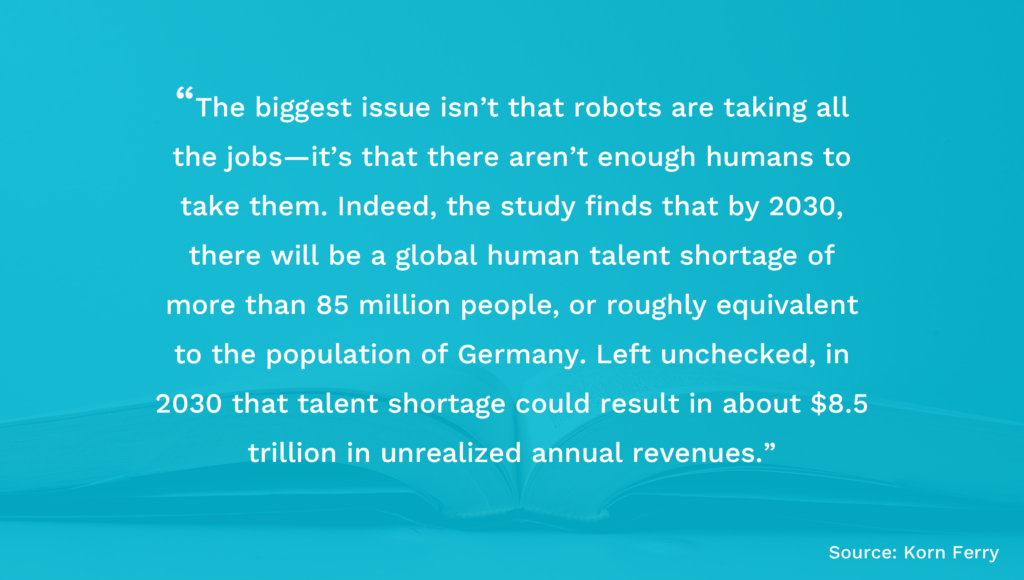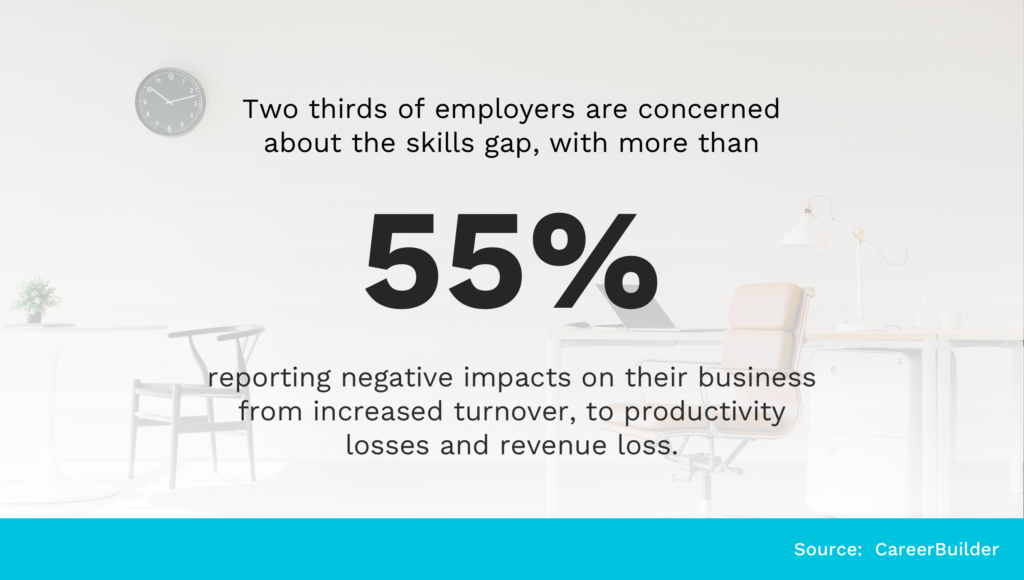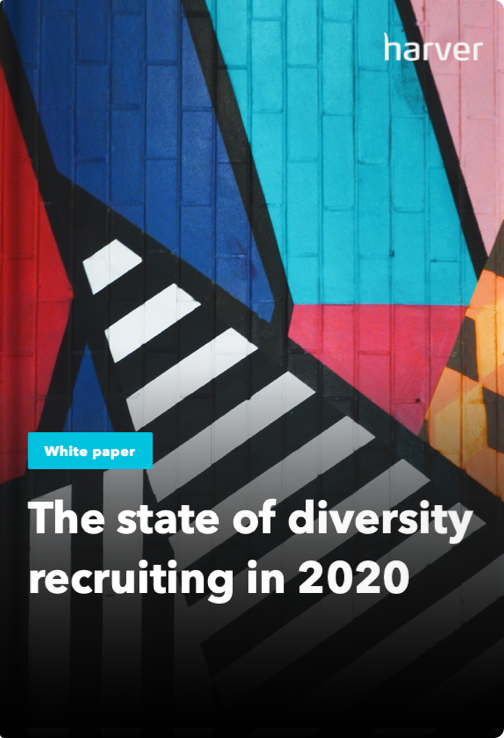The talent gap is a huge (and expensive) problem for many organizations. When employees lack the skills companies need to stay competitive, workers and the organizations themselves struggle meet operational demands and plan for the future.
But unfortunately, as much as we wish it would, the talent gap isn’t going to close itself. Organizations and employees need to work together to identify where the problems arise, what skills are needed, and how the right people can acquire those skills, either through sourcing the right talent or investing in existing team members.
Now, this sounds like a lofty goal. When the gap is so big, costing the economy over 2.5 trillion dollars over the next decade, how do you even know where to start?
Let’s break down the seven-step process you can follow to close the talent gap at your organization.
What’s in?
Like what you see?
Don’t miss out. Subscribe to our quarterly digest to get the latest TA and TM resources delivered right to your inbox.
What is a talent gap?
The talent gap is the space between your employees’ current level of talent, skill, or competencies and where you’d need them to be to meet your organization’s goals. This often happens because technology advances so quickly, it’s hard for employees to keep up—especially when they’re not actively trying.
Whether the rate of innovation excites you or it leaves you feeling overwhelmed, it feels like as soon as you catch up, the entire game changes. You blink and new software or processes appear, and you’re expected to be an expert in them all.
This is where the talent gap happens.

How to Close the Talent Gap
It’s not realistic to expect all employees to keep up with all changes. In fact, it can be a huge waste of time and money. Training new employees is expensive, and if the new skill or competency isn’t relevant to that person’s career path and role at the organization, teaching them something new won’t get you any closer to closing the gap.
Instead, you need to be strategic about how you train your employees. That way you can close your talent gap in an efficient way.
Here’s how to get started:
1. Conduct a talent gap analysis
Maybe you already know where your team comes up short or maybe you recognize there is a problem, you just can’t put your finger on it. Either way, the best place to get started is with a talent gap analysis (or sometimes referred to as a skills gap analysis).
A skills gap analysis evaluates where your team stands in relation to your organization’s goals. It looks at the future of work and trends in employment and how your existing employees stack up against the competition.
From there, you can learn what skills your team already possesses and where you might be able to improve. Knowing the specific competencies you need to develop is crucial for building your bridge over the talent gap. If you’re simply guessing at what will be important or assuming you have a skill you really don’t, you’ll only be wasting time and resources.
2. Rethink your recruitment strategy and process
If you’re seeing particularly large gaps in your talent, your recruitment strategy and process might need to be reworked. You might have a system in place that prevents employees with the right skills from getting hired, or is looking for the wrong competencies entirely.
In one example, you may hire for a role that requires a niche technical skill. Your recruiting team knows the skill is important, but they don’t fully understand the nuances. In the end, they may move candidates along for a variety of other important factors, and leave you with a candidate who has a basic understanding of the skill, while having missed top candidates because they didn’t fully understand the details.
On the other hand, your team may understand the skillset your teams need, but not be measuring them accurately in the hiring process, or could be relying too much on past experience when shortlisting talent. Say your roles require a high level of multi-tasking, customer orientation, and keen typing abilities – if you go off a resume alone, you may be hiring someone with the “right” background at the expense of someone with the strongest skillset.
If these patterns continue, you’ll never have the right person on your team.
Fixing this problem requires rethinking your hiring process, and looking for opportunities to improve candidate selection. Maybe you don’t need to train your recruiters on the niche skill you’re looking for, but you could add someone who has the skill to the hiring process. Or, in some cases, it may make the most sense to use a pre-employment assessment or a realistic job preview to see how someone’s skills match the job requirements.
That way, you can ensure your hiring process is truly vetting candidates for the skills you need to continue growing.

3. Find different sources of talent
We’ve all become dependent on typical job boards for finding talent. And while it is a good place to start, it can be restrictive—especially if you’re looking to hire for a specific skill or competency.
If you need to switch things up with your candidates, why not change the way you find talent?
There are tons of options out there. In addition to skill-specific job boards, consider connecting with a university with programs related to the skill you’re hiring for or professional development programs that might be able to filter some top candidates your way.
Here’s an example:
Let’s say you need to hire some new skilled coders. You’ve posted on job boards, but you’re not getting a lot of high-quality bites. Instead of settling for someone who can kind of get the job done, reach out to a coding program that might be able to introduce you to some candidates who fit the description you’re looking for.
Don’t get too caught up in whether or not the person is immediately ready to be hired. Certain educational programs, like Girls Who Code, might not have candidates old enough to be looking for a full-time career, but they might be looking for internship opportunities.
Making these kinds of connections early in their career can help you shape their professional development to fit your company’s needs—and gives you a reputation for being willing to work with growing students while they’re still finding their footing. This can come in handy if word gets around.
4. Build reskilling and upskilling programs
Hiring someone new isn’t always the answer when it comes to closing the skills gap. In fact, reskilling and upskilling your existing workforce whenever appropriate can save time and money, and create a stronger loyalty with your team.
Your existing workforce should want to continue to develop their skills. Not only does it make them more competitive and can add some excitement to their daily duties, providing opportunities with reskilling and upskilling can improve job satisfaction. When your team is happier in their roles, they’ll stick around longer.
Reskilling an employee is defined as having someone on your existing team learn an entirely new skill. For example, you might have a new office manager who really wants to transition into marketing. Putting in the time to train that employee to understand marketing and eventually moving them to the marketing department would be an example of reskilling.
Upskilling, on the other hand, is when a team member improves their skills to enhance their performance on their existing career path. For example, a coder who primarily creates websites for your team might learn how to code apps. While they learned a new skill, it didn’t set them on an entirely different career path—it just made them a more valuable member of their existing team.
But reskilling and upskilling can also be smaller, team wide initiatives. For example, bringing everyone on your team up to speed on a new software or tool you’re going to use is one example of upskilling.
You can reskill or upskill your team through online courses, sending a team member back to school, internal training sessions, or even just finding free resources online. There are lots of options available, regardless of your budget or company size.
The state of diversity recruiting in 2020
5. Put a mentoring program in place
You don’t need to go outside your organization to improve team member’s skills and competencies. In fact, you probably have a good number of qualified teachers right within the organization.
A mentoring program can help more experienced employees share their knowledge with some younger or less qualified members of the team. Having a mentoring program in place keeps learning consistent, so everyone is always growing.
Many organizations introduce a mentoring program when new hires just start. This is a great way to bring someone on board. However, everyone on your team can benefit from having a mentor—not just the newbies.
Connect employees based on skills they want to learn or how they want to grow. Matching employees based on competencies can ensure everyone is developing in a way that aligns with their personal and professional needs.

6. Focus on internal mobility
Alongside your reskilling and upskilling program, you need to prioritize internal mobility. While offering courses and mentoring programs is a great way to help team members learn something new, if there isn’t a clear path to a promotion or movement within the company, you might just be skilling your team to move on somewhere else.
If team members are taking the initiative to learn something new, reward them for it. Offer promotions when applicable, or just recognize their hard work if they’re not ready for that next level yet. A clear path to move up the ladder can help them understand what they’re working for.
Horizontal mobility is just as important. If your team starts to feel stuck in their current career, they might look outside the company for a fresh start. This could mean you’re losing some strong players.
If you have a path to a horizontal move, employees can explore new career paths and learn new things without having to leave. You get to retain top talent while your team member can work towards developing the career they actually want.
7. Work with contingent talent
Sometimes a project will pop up where you need a highly skilled employee and you need them quickly. You don’t have time to reskill or upskill an existing employee, and you’re not sure if you’re going to need that skill in the long-term. In these situations, the investment just isn’t worth it.
You can fill this gap by working with contingent talent. You can hire an individual for a specific project or for a designated length of time.
For example, let’s say a client has hired your marketing agency to create a new website. You don’t normally create websites, but you want the work. Instead of teaching an existing team member to create websites, you can hire a web developer for this specific project.
If the project goes well, you might be able to continue a freelance relationship or even hire the individual full-time. If you decide web development projects just aren’t for you, you can go your separate ways without losing time and money.
Conclusion
If you want to close the talent gap, you first need to know where it is. But just knowing what skills your team might be lacking isn’t enough.
Be strategic about planning your workforce needs and developing current employees. Through combining effective sourcing and recruiting with learning, reskilling, and upskilling, your existing workforce will help you close the talent gap at your organization.
The state of diversity recruiting in 2020


